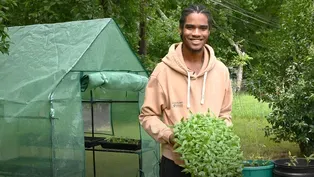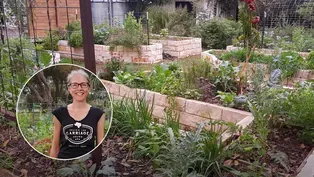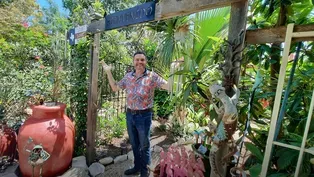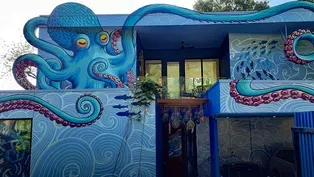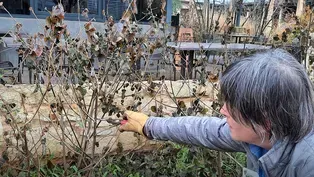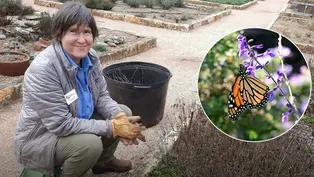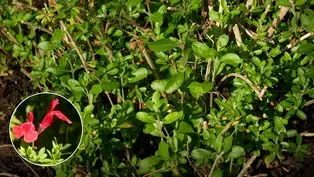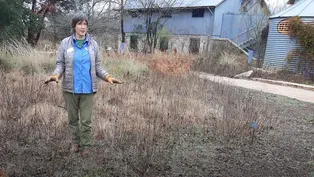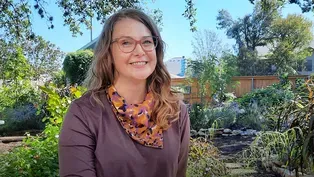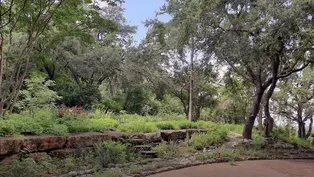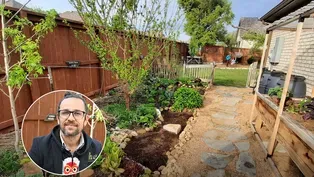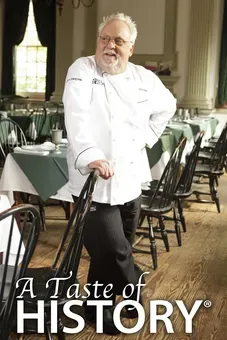
Garden Makeover Grows New Friends and Career
Clip: Season 28 | 9m 18sVideo has Closed Captions
Jennie Ostertag broke a few shovels changing her yard and life’s path.
Jennie Ostertag broke a few shovels turning her blank yard into magical moments for family, friends, and wildlife. But as she struck rock, sheet mulched grass, and reimagined salvaged materials on a budget, she met a community of equally-challenged gardeners happy to share plants and advice. When working the soil became solace after a stressful work day, Jennie changed her life’s path, too.
Problems with Closed Captions? Closed Captioning Feedback
Problems with Closed Captions? Closed Captioning Feedback
Central Texas Gardener is a local public television program presented by Austin PBS
Support for CTG is provided by: Lisa & Desi Rhoden, and Diane Land & Steve Adler. Central Texas Gardener is produced by Austin PBS, KLRU-TV and distributed by NETA.

Garden Makeover Grows New Friends and Career
Clip: Season 28 | 9m 18sVideo has Closed Captions
Jennie Ostertag broke a few shovels turning her blank yard into magical moments for family, friends, and wildlife. But as she struck rock, sheet mulched grass, and reimagined salvaged materials on a budget, she met a community of equally-challenged gardeners happy to share plants and advice. When working the soil became solace after a stressful work day, Jennie changed her life’s path, too.
Problems with Closed Captions? Closed Captioning Feedback
How to Watch Central Texas Gardener
Central Texas Gardener is available to stream on pbs.org and the free PBS App, available on iPhone, Apple TV, Android TV, Android smartphones, Amazon Fire TV, Amazon Fire Tablet, Roku, Samsung Smart TV, and Vizio.
Providing Support for PBS.org
Learn Moreabout PBS online sponsorship- Every season paths change and the plants change, the light changes.
And so, you know, kind of working with that taught me a lot about patience (laughs) and being open to having things change every season.
It never looks the same.
Hi, I'm Jennie Ostertag.
I'm a gardener and landscape designer here in Austin, Texas.
I moved back to Austin in 2012 and we came into this home when it was a completely blank slate.
All the soil back here, it's very heavy clay with a lot of limestone rock content.
So I've added a lot of leaf content, a lot of compost, a lot of mulch over the years to break that up.
But it did start out pretty gummy.
The compost additions have really lifted it.
And I leave a lot of the leaves too, even the oak leaves that are slower to break down.
I make sure to leave some of those or to chop them up so that it goes back into that soil and breaks it up.
So now the soil has become pretty good.
But it is very rocky.
(chuckles) I've joked that the I'm farming Texas potatoes, which really just like hunks of limestone.
(laughs) I've broken three shovels digging.
And that's when I was told that there are rock bars.
So I now have two rock bars.
So, hopefully, we'll be breaking fewer shovels.
The grass conversion back here.
It's happened over the last 10 years, basically.
So little by little, I have sheet composted and taken over invasive Bermuda grass and just dead soil.
The way this has all developed has been very organic and experimental, meaning there wasn't some master plan.
It's a constant state of evolution.
And so if I see a neighbor that had a load of bricks, this was five different neighbors that had bricks that I picked up at different times or all these flagstones and field stones.
Some of them were dug up in this yard through this process.
I worked from the outside in basically, starting at the back fence and the perimeters and then have worked my way towards the patio.
Part of how the garden developed the way it did is I was looking for the light and looking for where the soil was most receptive to planting when I started planting in those areas.
So the gardens back where my shed is, I had the best light in the yard there.
They got the most morning east-facing sunlight.
And so that was the easiest place to get plants to thrive.
And where I did a lot of experimentation.
And then as I spent more and more time here, I started to say, "Okay, where are the other magical moments of light and soil?"
So the next kind of special place in the yard was under this mott of oak trees where it was a really lovely place to sit.
And so it was saying, "Okay, I want to sit in this space.
Let me see what it would look like to build around that seating area."
So it was taking discrete places around the yard and saying, "What is drawing me there?
Is it the light?
Is it the soil?
What is making this moment special?
Or what can I see out of this window?
What do you see when you open the gate and walk through?
Or what do you see when you're literally taking out the trash and to greet you as you exit your kitchen?"
I like to have a lot of layering both in the plant material and in the little picture frame vignettes that catch your eye just to create a composition in that area.
So I think that's kind of how I try to approach it, is wherever your eye looks, to try and see it as a full composition with not just plant material but other things for your eye to land on.
Along this fence on the side here, when we first bought this house, it was the only area that I think had been gardened at all and it was just a bed of tropical sage.
But we wanted to have some screening along the side there.
The first things I planted were the wax myrtles, which are great for screening and hedge, but through our ice and snow storms, they have repeatedly been beaten back.
We had a huge ash growing back there as well.
That snowpocalypse.
Snowpocalypse took out the ash.
We replanted with a shumard oak.
I have American beautyberry, sweet almond verbena, Texas persimmon and sky pencil holly, evergreen sumac.
And in front of that is our rain garden.
We have storm water that comes through the side of our house and locates there.
So we would have a big area of our yard that was just a mud pit and would not drain quickly.
So, one year, I decided to build a rain garden and dug down and basically till I hit limestone bedrock about a foot down.
And that became kind of the basis for this planting area that collects water.
So when we get a big rain event, it will fill up, but it empties out within 24 hours for sure, sometimes in 4 to 8 hours, even if we have multiple inches of rain.
I come back here and do what I feel inspired to do on any given day or through what plants come to me, through friends or what you find on sale, or what's in season that inspires you that day.
I love salvia sages.
They're easy to take clippings of and share with neighbors.
And so that's how a lot of this got started, was pass-along plants.
The cannas, the salvias, the fountain grasses.
So much back here tells the story of my friends that are gardeners which has been really lovely.
And then during the pandemic, one of my friends, Rebecca, started a free plant stand not too far from here, where both for houseplants and plants in the yard, you can leave clippings or take rooted cuttings.
So a lot of it has come to feel like more of a designed composition over time as we do that sharing.
When you take one plant that multiplies and spread it around your garden, suddenly, it looks much more like an intentional design because you're using that repetition.
I have some supplemental drip irrigation, but it's very minimal.
I keep the things that need to be hand watered that are my precious plants in my pots near my back door where I collect rainwater.
The first pond I started with was just purely for rainwater collection.
I didn't have any plants growing in it.
I just put it under a gutter that collected rain 'cause I wanted to be able to water plants with rainwater.
And so the next one I put in was level with the ground where I got, again, from a neighbor, a tub that they were giving away that I think was a horse trough or something.
That one I buried in the ground because I wanted to have wildlife access to it.
So I wanted frogs and lizards and the birds and stuff to be able to go to the edge of the rocks and then be able to drink.
That kind of moved it more towards just wildlife, serving the wildlife versus just rainwater collection.
So, I put another trough with more plants and another bubbler where I can see it out of my kitchen window and made that the centerpiece of a memory garden for a friend of mine.
We have had major impacts from the last several freeze events.
The snowpocalypse took out the ash tree first.
And then the ice storm this February took out half of this ashe juniper cedar tree.
It opened up a lot more light, so it allowed for a lot more flowering things and perennials.
Where we saw the most change from losing a tree was in the front yard.
We had a huge live oak tree.
That was probably the main reason I was interested in seeing this house.
And when that ice storm finally took that tree out, it completely changed the light conditions.
So the front garden had to be reimagined because most of the things that had been under the canopy of that oak didn't survive the ice storm either.
So all of those plantings, probably 80% of the plantings had to be reimagined since February and were planted in April and May.
I was out gardening one day and just feeling I like the solitude of the garden, but I was feeling a bit alone in the challenge of gardening here and feeling like I just needed to talk about that and share that and learn from other people how they're responding to that and what I can do to help.
So I have not had a social media presence before I started this TikTok channel on a whim.
It's just the authentic what's happening in the garden today point of view.
And I think a lot of people responded to that and that resonated with people to say, "You can start small and you can do a lot of things for free or to work within community to build a garden over time."
Landscape design is a second career for me.
I spent 15 years in corporate HR in highly interactive people-facing roles, and my stress relief was coming out into the garden and having some solitude and really getting grounded physically and mentally in the soil.
It's been an evolution.
I don't know where the end will be, but much like what I love about gardening, I don't have to figure out the end right now.
We can see where this goes.
(chuckles)
Growing Community: Body and Soul
Video has Closed Captions
Lenny West found his anchor and mission in providing fresh vegetables to food desert neighbors. (6m 18s)
Native Plant Garden in HOA: Martin Byhower
Video has Closed Captions
A California-to-Texas environmentalist helps neighbors garden for wildlife in extreme weather. (8m 42s)
Permaculture Design: Raised Beds and Food Forest
Video has Closed Captions
Limestone raised beds and a mandala-designed food forest honor resourceful permaculture tenets. (9m 15s)
Creating Moods in a Regular Backyard
Video has Closed Captions
Imagination, creative reuse, and spirited fun turned a backyard into a sensory voyage. (7m 41s)
Video has Closed Captions
New gardener Nancy Hall relied on plants–adapted and native–to teach her their ways. (7m 49s)
Artistic Collaboration Goes with the Flow
Video has Closed Captions
When rainwater runoff plagued a family’s home, they plunged into a whimsical makeover. (8m 25s)
Winter Pruning: Wax Mallow for Spring’s Spiderworts
Video has Closed Captions
See how to cut back wax mallow (turk’s cap) to show off spring-blooming spiderworts. (3m 25s)
Winter Pruning: Mealy Blue Sage
Video has Closed Captions
See where to cut back old stalks on perennial mealy blue sage. (3m 16s)
Video has Closed Captions
Learn how to prune this evergreen woody shrub/subshrub. (4m 47s)
Video has Closed Captions
See why to progressively prune grasses and herbaceous perennials. (1m 35s)
Garden Makeover Grows New Friends and Career
Video has Closed Captions
Jennie Ostertag broke a few shovels changing her yard and life’s path. (9m 18s)
Video has Closed Captions
James Truchard created diverse habitats to offset a future of climate changes. (8m 49s)
Drought Design: Change of Plans & Plants
Video has Closed Captions
Mistakes led new gardeners back to the drawing board with native plants. (8m 55s)
Side Yard Garden Permaculture Design
Video has Closed Captions
A narrow side yard supports food and flowers with permaculture techniques. (8m 1s)
Front Yard Native Plant Wildlife Habitat
Video has Closed Captions
Removing lawn for native plants brings pollinators to a young couple’s front yard. (9m 35s)
Providing Support for PBS.org
Learn Moreabout PBS online sponsorshipSupport for PBS provided by:
Central Texas Gardener is a local public television program presented by Austin PBS
Support for CTG is provided by: Lisa & Desi Rhoden, and Diane Land & Steve Adler. Central Texas Gardener is produced by Austin PBS, KLRU-TV and distributed by NETA.
